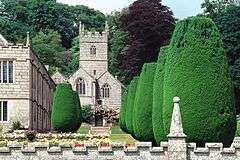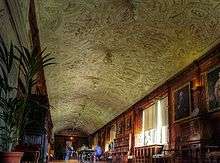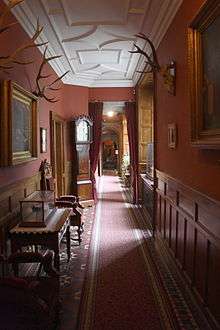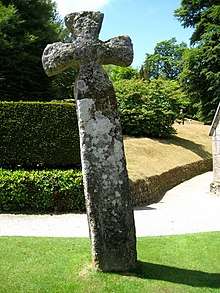Lanhydrock
Lanhydrock (Cornish: Lannhedrek,[1] meaning "church enclosure of St Hydrock") is a civil parish centred on a country estate and mansion in Cornwall, United Kingdom. The parish lies south of the town of Bodmin[2] and is bounded to the north by Bodmin parish, to the south by Lanlivery parish and to the west by Lanivet parish. The population was 171 in the 2001 census.[3] This increased to 186 in the 2011 census.[4] The Parish Council meets every two months in Lanhydrock Memorial Hall.[5]
Lanhydrock
| |
|---|---|
 Lanhydrock church | |
 Lanhydrock Location within Cornwall | |
| Population | 186 (Civil Parish, 2011) |
| OS grid reference | SX |
| Civil parish |
|
| Unitary authority | |
| Ceremonial county | |
| Region | |
| Country | England |
| Sovereign state | United Kingdom |
| Post town | Bodmin |
| Postcode district | PL30 |
| Dialling code | 01208 |
| Police | Devon and Cornwall |
| Fire | Cornwall |
| Ambulance | South Western |
| UK Parliament | |
Lanhydrock ecclesiastical parish is in the Deanery and Hundred of Pydar and in the Bodmin Registration District. The parish is in the Diocese of Truro and is now part of the Bodmin Team Ministry.[6]
The parish church is dedicated to St Hydroc and stands in the grounds of Lanhydrock House. Parts date back to the late 15th century and the church has a chancel, nave, north and south aisles and three-stage battlemented tower with nine bells. Eight bells date from the late 19th century and are regularly rung. The ninth bell dates from circa 1599 and is only rung infrequently for tolling.[7]
Lanhydrock House





The great house stands in extensive grounds (360 hectares or 890 acres) above the River Fowey and it has been owned and managed by the National Trust since 1953.[8] Much of the present house dates back to Victorian times but some sections date from the 1620s. It is a Grade I listed building[9] and is set in gardens with formal areas. The hill behind the house is planted with a fine selection of shrubs and trees.[10]
Early history
Lanhydrock estate belonged to the Augustinian priory of St Petroc at Bodmin but the Dissolution of the Monasteries during the 1530s saw it pass into private hands. In 1620 wealthy merchant Sir Richard Robartes, of Truro, acquired the estate and began building Lanhydrock House, designed to a four-sided layout around a central courtyard and constructed of grey granite. Robartes died in 1624 but work on the building was continued by his son John Robartes, 1st Earl of Radnor, a notable public figure who served as Lord Privy Seal and Lord President of the Council. The embattled walls were built of rude (rough), massive granite blocks with years 1636 and 1642 on the walls, indicating when they were built. A barbican gate was added and the house was garrisoned by Parliamentary forces in August 1644 when Sir Richard Grenville took possession.[11]
Agar-Robartes
Most of the current building dates from late Victorian times, when the estate came under the ownership of the Agar-Robartes family.
Through a lack of children, by the late 18th century the estate had passed to Anna Maria Hunt (1771–1861) of Mayfair, London, the great-niece of Henry Robartes, 3rd Earl of Radnor and 4th Baron Robartes. In 1804 she married Charles Bagenal Agar, the youngest son of Irish peer James Agar, 1st Viscount Clifden. The couple had three children, but by 1818 not only had her husband died, but also her eldest and youngest sons. Resultantly, over the next 50 years of widowhood, although mainly a remote landlord – she preferred the social life of London – she was known to be a conscientious, benevolent and charitable landlord and employer, who greatly improved the estate. On the death of his mother in 1822, her surviving middle son Thomas Agar moved his home to the estate, and adopted the Robartes name by warrant. Agar-Robartes was returned to Parliament for Cornwall East in 1847, a seat he held until 1868. In 1869 the barony of Robartes held by his mother's ancestors was revived when he was raised to the peerage as Baron Robartes of Lanhydrock, and of Truro in the County of Cornwall. By 1872 Baron Robartes of Lanhydrock, was listed in the top ten land holdings in Cornwall with an estate of 22,234 acres (89.98 km2) or 2.93% of Cornwall.[12]
Agar-Robartes had had the east wing of the house demolished, leaving the U-shaped plan seen today. In 1880 he commissioned the architect George Gilbert Scott to renovate Lanhydrock House. On 4 April 1881 a major fire destroyed the south wing and caused extensive damage to the central section. The fire started in the kitchen and the near gale-force wind fanned the flames along the south wing and the ″communicating block″.[11] Of the main house only the north wing, with its 116 feet (35 m) Long Gallery, and the front porch building survived intact, along with the original gatehouse which also dates back to the mid-17th century. The gallery was decorated with old plaster work which was considered to be the finest of its type in the west of England with figures representing the creation in ″bas-relief″. The property was insured for £10,000 in the Royal Standard Office and for £10,000 in the County Fire Office and the damage is estimated to cost £8,000 to £10,000[11] It was reported in August 1881 that the rebuilding of the house would cost £50,000 and was to be undertaken by Messers Lang and Son of Liskeard.[13] New sections were built behind the south wing, including a kitchen block, in the style of the original building – which was unusual at the time. Agar-Robartes wife died five days after the fire of smoke inhalation, and he died of a broken heart 12 months later.[14]
Their only son Thomas Charles Agar-Robartes, 6th Viscount Clifden inherited the estate. He appointed local architect Richard Coad – who had worked as an assistant to George Gilbert Scott – to design and supervise the construction of a high-Victorian home from the previous adaptions of a Jacobean house his father had planned. After renovations on the home were completed, Agar-Robartes moved his family there from 1885. Having been called to the Bar in 1870,[15] in 1880 Agar-Robartes was returned to Parliament as one of two representatives for Cornwall East. He entered the House of Lords on the death of his father in 1882,[15][16] and on 10 September 1899 succeeded his kinsman as sixth Viscount Clifden. In 1891, as chairman of the Agar-Robartes Bank he took over the ownership of Wimpole Hall, the largest house in Cambridgeshire. Moving his family home there, he later served as Lord-Lieutenant of Cambridgeshire from 1906 to 1915.[15]
The Robartes family declined significantly during the First World War, including the heir Thomas Agar-Robartes MP, who was killed during the Battle of Loos in France, while trying to rescue a colleague from no-man's land. Only one descendant survives, living in a cottage on the estate.
Antiquities

Arthur Langdon (1896) recorded two Cornish crosses and two cross bases (at Tredinnick Cross and Reperry)[17] in the parish. One cross is in the churchyard and the other is half a cross head at Treffry. The cross in the churchyard is ornamented on all four sides of the shaft.[18] In addition to these there is a cross called Bodwen Cross; this cross was recorded in 1850 but was not mentioned by J. T. Blight or Arthur Langdon. It was found again in 1937 near Helman Tor in the parish of Lanlivery. It was taken from there and erected in the new cemetery at Lanhydrock. A request for it to be returned to Lanlivery to a site on the Saints' Way was refused.[19]
Lanhydrock Estate Company
In 1934, to manage income taxes and death duties, the entire Cornish landholdings of the Agar-Roberts family were incorporated into the Lanhydrock Estate Company. In 1953, faced with crippling death duties through a lack of his own children, the 7th Viscount Clifden gave the house and approximately 160 hectares (400 acres) of parkland to the National Trust. This allowed the preservation of the house and its extensive Victorian collections, and, by agreement with HM Revenue, payment in kind of death duties, allowing the residual Lanhydrock Estate Company to pass into the hands of the wider family.
On the death of the 7th Viscount, the titles and control of the company passed to his youngest brother Arthur Agar-Robartes, 8th Viscount Clifden. Lord Clifden died in December 1974, and in a similar death duty exchange with HM Revenue, added 298 acres during the 1970s to the National Trust's estate holdings.[20] He had married Patience Mary Basset in 1920 but died without male issue, and upon his death all his titles, with the exception of the barony of Mendip (which the 6th Earl of Normanton succeeded) became extinct.[21] His daughter Rachel married Captain Cromwell Lloyd-Davies RN, DSO DSC in 1941, and they had a daughter Ann Lloyd-Davies (1942–present). In 1964 she married Colin Williams; they and their three children now control the company.[22]
As of 2020 the company owns and controls 2,500 acres of land, and is by descent controlled by the Williams family.
House and gardens today
Today, the public tour of Lanhydrock house is one of the longest of any National Trust house. It takes in the service rooms, nurseries and some servants' bedrooms, as well as the main reception rooms and family bedrooms. In 2004 it was one of the Trust's ten most visited paid-entry properties, with over 200,000 visitors.
Parts of the estate have been designated as an Important Plant Area, by the organisation Plantlife, for its ancient woodland and lichens.[23]
Lanhydrock was the main setting for a 1996 film version of Twelfth Night directed by Trevor Nunn, and starring Helena Bonham Carter as Olivia. On 12 June 2008 Lanhydrock hosted an episode of BBC TV's Antiques Roadshow, which was first aired on 12 October 2008 (part 1) and 30 November 2008 (part 2).
References
- Place-names in the Standard Written Form (SWF) Archived 15 May 2013 at the Wayback Machine : List of place-names agreed by the MAGA Signage Panel Archived 15 May 2013 at the Wayback Machine. Cornish Language Partnership.
- Ordnance Survey: Landranger map sheet 200 Newquay & Bodmin ISBN 978-0-319-22938-5
- GENUKI website; Lanhydrock; retrieved May 2010
- "2011 census". Retrieved 6 February 2015.
- Cornwall Council website Archived 3 January 2009 at Archive.today; retrieved May 2010
- Church of England "A Church Near You" website; St Hydroc, Bodmin; retrieved May 2010
- "Dove Details". dove.cccbr.org.uk. Retrieved 11 July 2016.
- National Trust website: Lanhydrock Archived 30 April 2010 at the Wayback Machine; retrieved May 2010
- Historic England. "Details from listed building database (1157870)". National Heritage List for England. Retrieved 22 April 2007.
- "Lanhydrock". National Trust.
- "Great Fire at Lanhydrock House, The Seat of Lord Robartes". The Cornishman (143). 7 April 1881. p. 5.
- Who Owns Britain – by Kevin Cahill (author)
- "Local News". The Cornishman (162). 18 August 1881. p. 6.
- "Salvation and tragedy: 1798–1881". National Trust. Retrieved 24 January 2018.
- thepeerage.com Thomas Charles Agar-Robartes, 6th Viscount Clifden of Gowran
- Leigh Rayment's Historical List of MPs – Constituencies beginning with "C" (part 6)
- For more details of Reperry Cross, see Lanivet
- Langdon, A. G. (1896) Old Cornish Crosses. Truro: Joseph Pollard; pp. 382–83, 183, 227 & 423
- Langdon, A. G. (2002) Stone Crosses in Mid Cornwall; 2nd ed. Federation of Old Cornwall Societies; p. 42
- "Lanhydrock in the 20th century". National Trust. Retrieved 14 January 2020.
- "Arthur Victor Agar-Robartes, 8th Viscount Clifden of Gowran". thepeerage.com. Retrieved 2 January 2017.
- https://family-tree.cobboldfht.com/tree/view/person:4804
- "Lanhydrock Park". Plantlife. Archived from the original on 1 July 2012. Retrieved 7 February 2012.
External links
| Wikimedia Commons has media related to Lanhydrock. |